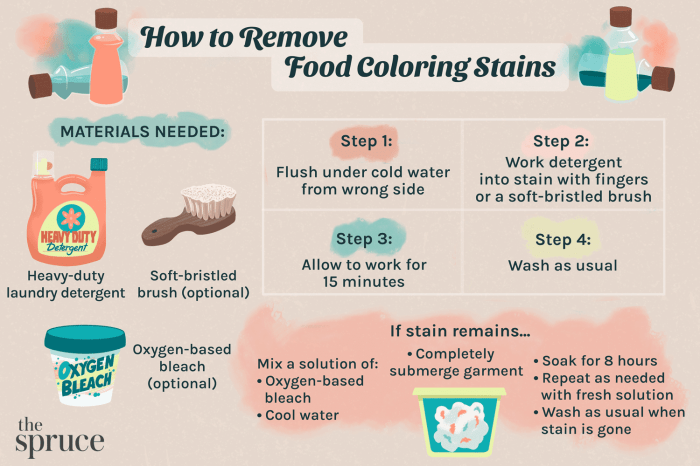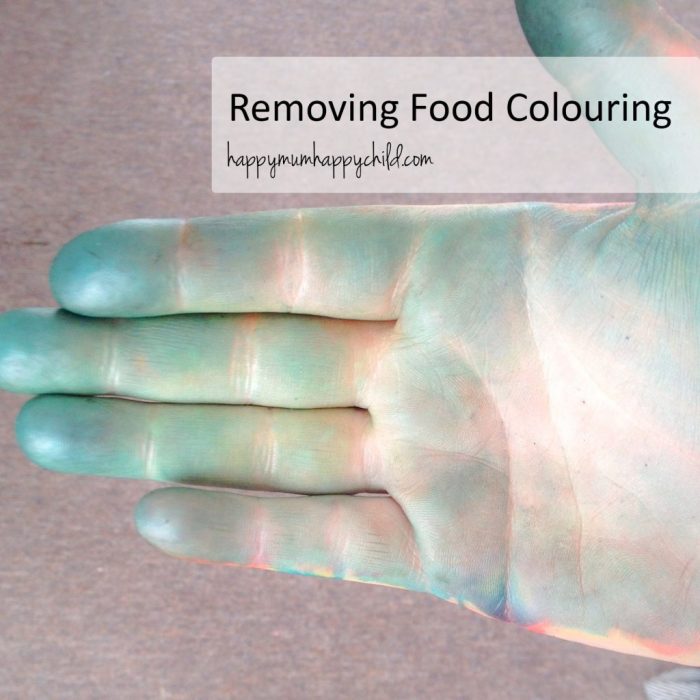Removing Food Coloring from Hair: How To Get Food Coloring Off

How to get food coloring off – Getting food coloring out of your hair can be a frustrating experience, but with the right approach, it’s often manageable. The key is to act quickly and use gentle methods to avoid further damaging your hair. The success of removal depends on several factors, including the type of food coloring used, the hair type, and how long the color has been in contact with the hair.
The tenacious nature of food coloring stains often presents a domestic challenge; effective removal frequently depends on the type of coloring and the stained surface. Understanding the properties of the stain, such as with vibrant hues like those achieved using purple powder food coloring , is crucial. Therefore, a tailored approach, considering both the coloring agent and the material it has impacted, is necessary for successful stain removal.
Strategies for Removing Food Coloring from Different Hair Types
Hair type significantly impacts how easily food coloring can be removed. Straight hair tends to be more resilient and less porous than curly hair, making removal potentially easier. Fine hair is more delicate and prone to damage, requiring gentler approaches. Thick hair, while potentially more resistant to initial staining, may require more thorough treatment. Regardless of hair type, immediate action is crucial.
- Straight Hair: For straight hair, a clarifying shampoo followed by a deep conditioner is often sufficient. The clarifying shampoo helps lift the color, while the conditioner replenishes moisture lost during the cleansing process. Avoid harsh scrubbing, as this can damage the hair cuticle.
- Curly Hair: Curly hair’s texture can trap food coloring more easily. A gentle cleansing conditioner or co-wash may be preferable to a harsh shampoo. Follow with a deep conditioning treatment to minimize dryness and breakage. Consider using a wide-tooth comb to detangle gently, avoiding aggressive brushing.
- Fine Hair: Due to its delicate nature, fine hair requires the most gentle approach. A mild, sulfate-free shampoo followed by a leave-in conditioner is recommended. Avoid frequent washing, as this can strip the hair of its natural oils and cause further damage.
- Thick Hair: Thick hair may require more time and effort for complete color removal. You might need to repeat the clarifying shampoo and deep conditioner process several times, but always allow ample time between washes to prevent over-drying.
Common Mistakes When Removing Food Coloring from Hair
Several common mistakes can hinder the removal process and even cause damage. Understanding these pitfalls can help you avoid them.
- Using Harsh Chemicals: Aggressive chemicals can strip the hair of its natural oils, leading to dryness, breakage, and further damage. Opt for gentle, hair-specific products instead.
- Over-Washing: Excessive washing can weaken the hair shaft and lead to dryness. Space out washing sessions to allow the hair to recover between treatments.
- Ignoring Deep Conditioning: Food coloring removal often leads to dryness. Deep conditioning is crucial to restore moisture and prevent damage.
- Using the Wrong Tools: Aggressive scrubbing or brushing can cause breakage and damage. Use gentle techniques and appropriate tools for your hair type.
Gentle Hair-Care Products for Food Coloring Stain Removal
A selection of gentle hair care products can assist in the removal of food coloring stains. The key is to choose products that are designed to be mild and moisturizing.
- Sulfate-Free Shampoo: Sulfates are harsh detergents that can strip the hair of its natural oils. Sulfate-free shampoos are gentler and less likely to cause damage.
- Clarifying Shampoo: Clarifying shampoos are designed to remove buildup from hair products and environmental pollutants. They can help lift food coloring from the hair shaft.
- Deep Conditioner: Deep conditioners help to replenish moisture lost during the cleansing process and improve hair health.
- Leave-in Conditioner: Leave-in conditioners provide continuous moisture and protection, especially beneficial for fine or damaged hair.
- Cleansing Conditioner (Co-wash): A cleansing conditioner is a gentler alternative to traditional shampoo, suitable for curly or dry hair.
Preventing Food Coloring Stains

Preventing food coloring stains requires proactive measures and mindful practices. Understanding the nature of food coloring – its vibrant intensity and tendency to bind to fabrics and surfaces – is crucial in minimizing the likelihood of accidental staining. By implementing preventative strategies, you can significantly reduce the stress and effort associated with cleaning up spills and preserving the appearance of your clothes, skin, and work surfaces.Proper preparation and the use of protective gear are paramount in preventing food coloring stains.
Food coloring, especially liquid varieties, can be remarkably difficult to remove once it sets. Therefore, a proactive approach is far more effective than reactive cleanup.
Protective Gear Usage
Using protective gear is not merely a suggestion; it’s a fundamental element of safe and efficient food coloring handling. Gloves, ideally disposable nitrile or latex gloves, prevent direct skin contact, thus avoiding potential staining and irritation. An apron, preferably made from a stain-resistant material like plastic or coated fabric, protects clothing from spills and splatters. Eye protection, such as safety glasses, can also be beneficial, especially when working with larger quantities of food coloring or during potentially messy activities like mixing large batches.
These simple precautions create a significant barrier against accidental staining, allowing you to focus on your task without the added anxiety of potential messes.
Visual Guide: Proper Food Coloring Handling Techniques
Imagine a visual guide depicting four distinct panels. The first panel shows a person meticulously pouring food coloring from a bottle into a measuring cup, holding the bottle close to the cup to minimize spillage. The second panel displays the careful addition of food coloring to a mixing bowl, using a spoon or spatula to gently incorporate the color into the batter or mixture.
The third panel showcases the correct way to clean up small spills immediately using a damp cloth or sponge, blotting rather than rubbing. The final panel shows the proper disposal of used materials, emphasizing the importance of washing out containers thoroughly and disposing of gloves and aprons responsibly. This visual guide emphasizes slow, deliberate movements, controlled pouring, and immediate cleanup of any accidental spills.
This systematic approach significantly reduces the chance of staining.
Surface Protection, How to get food coloring off
Protecting your work surfaces is equally important. Before beginning any project involving food coloring, cover your workspace with a disposable covering, such as newspaper, parchment paper, or a plastic tablecloth. This provides a sacrificial layer that will absorb any spills, preventing staining of countertops or tables. For projects involving more extensive mixing or blending, consider working over a sink or a large, easily cleaned surface to facilitate quick cleanup.
Remember, preparation is key in preventing unwanted stains and reducing the time spent on post-project cleaning.
Question & Answer Hub
What’s the best way to prevent food coloring stains?
Prevention is key! Wear protective gloves and aprons, work over a protected surface, and immediately blot up any spills.
Can I use bleach to remove food coloring stains?
While bleach can sometimes work, it can also damage fabrics and surfaces. It’s best to try gentler methods first.
How do I remove food coloring from carpet?
Blot the stain immediately with a clean cloth and cold water. For tougher stains, try a mixture of mild dish soap and water, followed by a thorough rinsing.
Is it safe to use baking soda on all surfaces?
Baking soda is generally safe, but test it on an inconspicuous area first, especially on delicate surfaces like marble.
